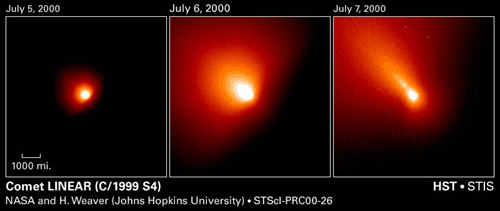Astronomers got more than they bargained for last summer when comet C/LINEAR unexpectedly disintegrated while at its most visible from Earth. Routine observations of the passing comet gleaned valuable information from the surprise fragmentation, and analysis has now shed light on the origin, composition and motion of the ancient body. Insights into the formation of comets are fundamental to our understanding of how planets coalesce, a process thought to be closely related.

The theory that primordial comet impacts seeded life on Earth has been boosted by the unusual make-up of organic compounds discovered in C/LINEAR. Certain compounds common in other comets were scarce on C/LINEAR, but the relative proportion of hydrogen isotopes matches that in the Earth’s oceans. “For the first time, we have seen a comet with the right composition to do the job”, explains Michael Mumma of the NASA Goddard Space Flight Center. Mumma and co-workers compared the organic make-up of C/LINEAR with comets Halley, Hyakutake, Hale-Bopp and Lee, which probably formed in a cold region beyond Neptune’s orbit (M Mumma et al 2001 Science 292 1334). Frozen volatile compounds would be amalgamated into these comets, but the observed lack of these materials in C/LINEAR suggests that it coalesced in a warmer region near Jupiter and Saturn.
Meanwhile, Hal Weaver of Johns Hopkins University led a French-American collaboration that used the Hubble Space Telescope and the ground-based Very Large Telescope to examine the break-up of C/LINEAR (H Weaver et al 2001 Science 292 1329). Weaver and colleagues counted 16 large fragments up to 100 metres across, as well as a host of smaller particles. The team speculates that the fragments they observed could be those that originally fused to form the comet – and so could reveal the composition of the protoplanetary nebula. Evaporation of volatile compounds often causes comets to decompose as they approach the Sun, but the near-absence of such compounds on C/LINEAR suggests that it may instead have broken up simply because it was fragile and spinning quickly.
Emissions of gas from C/LINEAR were monitored over a four-week period by Dominique Bockelée-Morvan of the Observatoire de Paris-Meudon and colleagues (D Bockelée-Morvan et al 2001 Science 292 1339). Their radiotelescope observations of various other gases that vaporized as the comet neared the Sun provide clues about the chemical composition of the nebula from which it formed. The temperature profile of the comet’s path was also deduced from the sequence of evaporation of different gases.
Photometric measurements made before and after the comet split apart also suggest that comet C/LINEAR may have been more massive than originally thought. Tony Farnham of the University of Texas, US, headed a team that estimated the diameter of the comet’s nucleus to be just under 500 metres (T Farnham et al 2001 Science 292 1348). But a calculation based on this figure predicts that the comet was originally a thousand times more massive than the group thought, based on its estimate of the mass of the comet’s tail – 300 million kilograms. This is probably because many medium-sized fragments go undetected: they are too small to observe directly and too large to contribute to the light reflected by the comet’s tail.
Teemu Mäkinen of the Finnish Meteorological Institute and co-workers believe that 300 million kilograms of water vaporized from comet C/LINEAR in the period leading up to its disintegration (J Mäkinen et al 2001 Science 292 1326). Ice is widely thought to be the ‘glue’ that holds comets together, and the periodic bursts of water vapour ejected from C/LINEAR are thought to indicate the spacing of ice pockets within.
Although dissimilar from other comets in many respects, C/LINEAR is typical in terms of its X-ray profile. Carey Lisse of the University of Maryland, US, and colleagues monitored the X-ray output of the comet at the Chandra X-ray Observatory (C Lisse et al 2001 Science 292 1343). They believe that the emissions arose from collisions between highly charged ions in the solar wind with gas molecules and atoms emitted from the comet. Although the combination of gases seeping from the comet was unusual, its X-ray profile was remarkably similar to those of other well-known comets. Lisse and colleagues add that a powerful solar flare produced a strong peak in the X-ray output of C/LINEAR, which makes such X-rays emissions a useful way to probe the solar wind.





